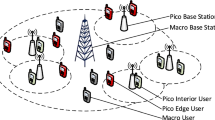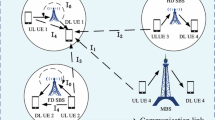Abstract
Due to the non-uniform distribution of users in a cellular area, there are users with similar channel conditions. In non-orthogonal multiple access (NOMA) systems, a small difference in channel gains of paired users can cause interference in end users, which so-called imperfect successive interference cancellation (SIC) and correspondingly, it causes serious degradation in the system capacity. In NOMA, most of the user pairing algorithms focus on pairing near and far users with each other, and about mid-users there are two options. First, pairing these users together over a common frequency band, which makes some degradation in capacity, due to imperfect SIC. Second, unpairing these users together, which makes mid-users cannot enjoy the benefits provided by the NOMA strategy. In this article to address these issues, a novel user pairing approach is proposed where all far, near, and mid-cell users can pair together based on the interference mitigation, and enjoy the advantages of NOMA. To evaluate the performance of this scenario, the ergodic sum capacity is calculated in both perfect and imperfect SIC modes, and also compared with the benchmark scheme. In addition, we provide a performance analysis of the proposed scheme in terms of user fairness and outage probability, and also investigate the effect of the resources (power/bandwidth) distribution among users on the system performance. Analytical computations and corresponding simulation results, confirm the performance enhancement of the proposed scheme in terms of the system capacity, outage probability, and user fairness.
















Similar content being viewed by others
References
Ding, Z., et al. (2017). A survey on non-orthogonal multiple access for 5G networks: Research challenges and future trends. IEEE Journal on Selected Areas in Communications, 35(10), 2181–2195.
Chen, Y., et al. (2018). Toward the standardization of non-orthogonal multiple access for next generation wireless networks. IEEE Communications Magazine, 56(3), 19–27.
Saito, Y., Kishiyama, Y., Benjebbour, A., Nakamura, T., Li, A., & Higuchi, K. (2013). Non-orthogonal multiple access (NOMA) for cellular future radio access. In 2013 IEEE 77th vehicular technology conference (VTC Spring) (pp 1–5).
Benjebbour, A., Li, A., Saito, K., Saito, Y., Kishiyama, Y., & Nakamura, T. (2015). NOMA: From concept to standardization. In 2015 IEEE conference on standards for communications and networking (CSCN) (pp. 18–23).
Higuchi, K., & Benjebbour, A. (2015). Non-orthogonal multiple access (NOMA) with successive interference cancellation for future radio access. IEICE Transactions on Communications, 98(3), 403–414.
Ding, Z., Liu, Y., Choi, J., Sun, Q., Elkashlan, M., Chih-Lin, C. L., et al. (2017). Application of non-orthogonal multiple access in LTE and 5G networks. IEEE Communications Magazine, 55(2), 185–191.
Tao, Y., Liu, L., Liu, S., & Zhang, Z. (2015). A survey: Several technologies of non-orthogonal transmission for 5G. China Communications, 12(10), 1–15.
Moltafet, M., Mokari, N., Javan, M. R., Saeedi, H., & Pishro-Nik, H. (2018). A new multiple access technique for 5G: Power domain sparse code multiple access (PSMA). IEEE Access, 6, 747–759.
Bai, L., Zhu, L., Li, T., Choi, J., & Zhuang, W. (2018). An efficient hybrid transmission method: Using non-orthogonal multiple access and multiuser diversity. IEEE Transactions on Vehicular Technology, 67(3), 2276–2288.
Bharathi, S., Nandita, L., Venkateswaran, N., & Subhashini, R. (2017). Performance analysis of non-orthogonal multiple access technique with precoding. In 2017 international conference on wireless communications, signal processing and networking (WiSPNET) (pp. 1878–1882).
Saito, Y., Benjebbour, A., Kishiyama, Y., & Nakamura, T. (2015). System-level performance of downlink non-orthogonal multiple access (NOMA) under various environments. In 2015 IEEE 81st vehicular technology conference (VTC Spring) (pp. 1–5).
Ding, Z., Fan, P., & Poor, H. V. (2016). Impact of user pairing on 5G non-orthogonal multiple access downlink transmissions. IEEE Transactions on Vehicular Technology, 65(8), 6010–6023.
Shahab, M. B., Kader, M. F., & Shin, S. Y. (2016). A virtual user pairing scheme to optimally utilize the spectrum of unpaired users in non-orthogonal multiple access. IEEE Signal Processing Letters, 23(12), 1766–1770.
Shahab, M. B., Irfan, M., Kader, M. F., & Shin, S. Y. (2016). User pairing schemes for capacity maximization in non-orthogonal multiple access systems. Wireless Communications and Mobile Computing, 16(17), 2884–2894.
Shahab, M. B., Kader, M. F., & Shin, S. Y. (2016). On the power allocation of non-orthogonal multiple access for 5G wireless networks. In 2016 international conference on open source systems & technologies (ICOSST) (pp. 89–94).
Al-Abbasi, Z. Q., & So, D. K. (2016). User-pairing based non-orthogonal multiple access (NOMA) system. In 2016 IEEE 83rd vehicular technology conference (VTC Spring) (pp. 1–5).
Yang, Z., Pan, C., Xu, W., Pan, Y., Chen, M., & Elkashlan, M. (2018). Power control for multi-cell networks with non-orthogonal multiple access. IEEE Transactions on Wireless Communications, 17(2), 927–942.
Chen, L., Ma, L., & Xu, Y. (2019). Proportional fairness-based user pairing and power allocation algorithm for non-orthogonal multiple access system. IEEE Access, 7, 19602–19615.
Liu, Y., et al. (2019). On the fairness performance of NOMA-based wireless powered communication networks. [Online]. arXiv:1906.00186.
Al-Wani, M. M., et al. (2019). On short term fairness and throughput of user clustering for downlink non-orthogonal multiple access system. In 2019 IEEE 89th vehicular technology conference (VTC2019-Spring) (pp. 1–6).
Wei, Z., Guo, J., Ng, D. W. K., & Yuan, J. (2017). Fairness comparison of uplink NOMA and OMA. In 2017 IEEE 85th vehicular technology conference (VTC Spring) (pp. 1–6).
Zeng, M., Yadav, A., Dobre, O. A., Tsiropoulos, G. I., & Poor, H. V. (2017). Capacity comparison between MIMO-NOMA and MIMO-OMA with multiple users in a cluster. IEEE Journal on Selected Areas in Communications, 35(10), 2413–2424.
Jain, R. K., Chiu, D.-M., & Hawe, W. R. (1984). A quantitative measure of fairness and discrimination for resource allocation in shared computer systems. DEC Research Report TR-301.
Miandoab, F. T., & Tazehkand, B. M. (2019). A user pairing method to improve the channel capacity for multiuser MIMO channels in downlink mode based on NOMA. Computer Communications, 146, 15–21.
Capozzi, F., Piro, G., Grieco, L., Boggia, G., & Camarda, P. (2013). Downlink packet scheduling in LTE cellular networks: Key design issues and a survey. IEEE Communications Surveys & Tutorials, 15(2), 678–700.
Zeng, R., Liu, T., Yu, X., & Zhang, Z. (2019). Novel channel quality indicator prediction scheme for adaptive modulation and coding in high mobility environments. IEEE Access, 7, 11543–11553.
Attalla, S. A., et al. (2018). Soft-sensing CQI feedback-based access scheme in cognitive radio networks. IEEE Transactions on Cognitive Communications and Networking, 4(3), 486–499.
Fuente, A. D. L., Femenias, G., Riera-Palou, F., & Armada, A. G. (2018). Subband CQI feedback-based multicast resource allocation in MIMO-OFDMA networks. IEEE Transactions on Broadcasting, 64(4), 846–864.
Kolehmainen, N., et al. (2008). Channel quality indication reporting schemes for UTRAN long term evolution downlink. In IEEE vehicular technology conference (VTC Spring 2008) (pp. 2522–2526).
Grassi, A., Piro, G., Bacci, G., & Boggia, G. (2017). Uplink resource management in 5G: When a distributed and energy-efficient solution meets power and QoS constraints. IEEE Transactions on Vehicular Technology, 66(6), 5176–5189.
Shahab, M. B., & Shin, S. Y. (2017). On the performance of a virtual user pairing scheme to efficiently utilize the spectrum of unpaired users in NOMA. Physical Communication, 25(2), 492–501.
Author information
Authors and Affiliations
Corresponding author
Additional information
Publisher's Note
Springer Nature remains neutral with regard to jurisdictional claims in published maps and institutional affiliations.
Rights and permissions
About this article
Cite this article
Tabee Miandoab, F., Tazehkand, B.M. NOMA performance enhancement-based imperfect SIC minimization using a novel user pairing scenario involving three users in each pair. Wireless Netw 26, 3735–3748 (2020). https://doi.org/10.1007/s11276-020-02300-8
Published:
Issue Date:
DOI: https://doi.org/10.1007/s11276-020-02300-8




